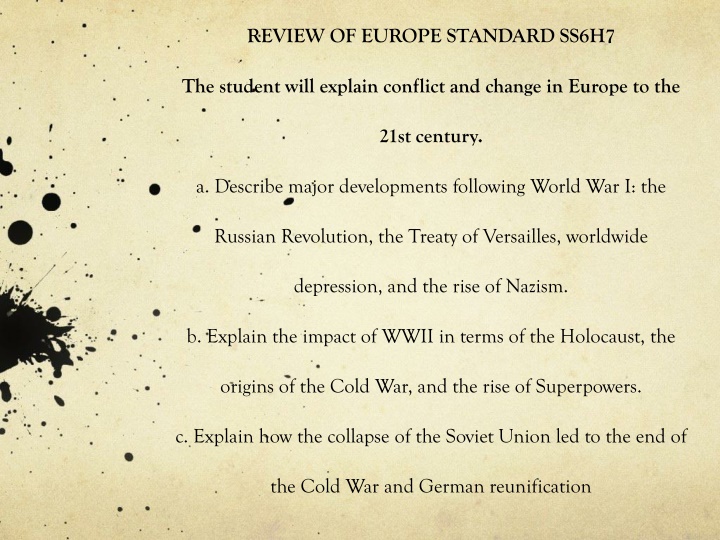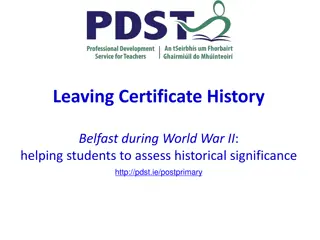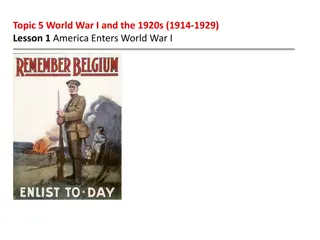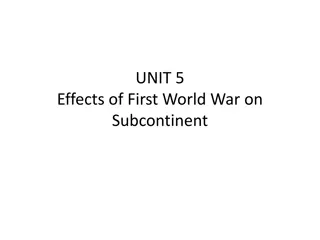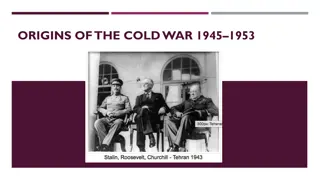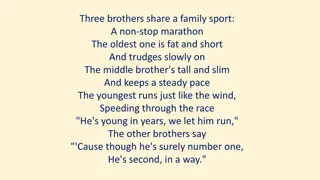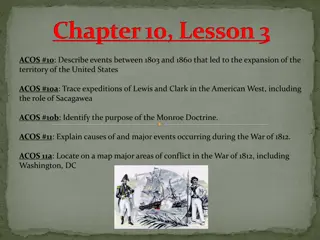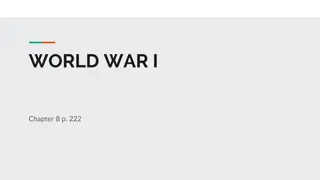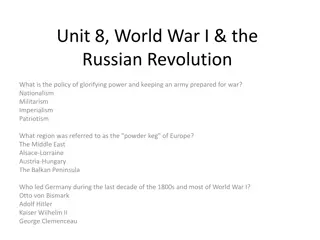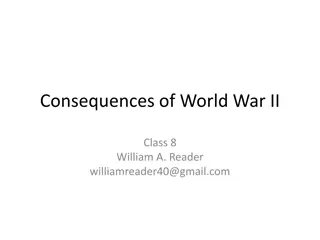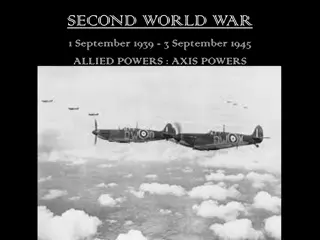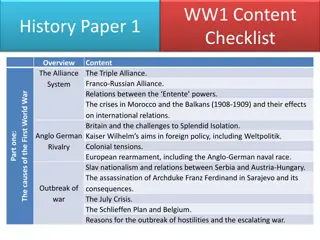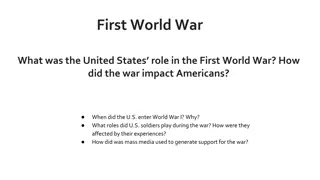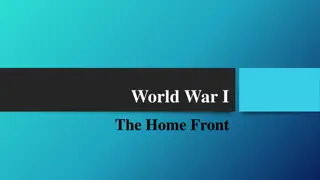Major Developments Following World War I: Impacts and Events
World War I, starting in 1914 with the assassination of Archduke Ferdinand, led to significant developments such as the Treaty of Versailles, worldwide depression, and the rise of Nazism. The war had profound effects on global geopolitics and economies, setting the stage for further conflicts and changes in Europe.
Download Presentation

Please find below an Image/Link to download the presentation.
The content on the website is provided AS IS for your information and personal use only. It may not be sold, licensed, or shared on other websites without obtaining consent from the author.If you encounter any issues during the download, it is possible that the publisher has removed the file from their server.
You are allowed to download the files provided on this website for personal or commercial use, subject to the condition that they are used lawfully. All files are the property of their respective owners.
The content on the website is provided AS IS for your information and personal use only. It may not be sold, licensed, or shared on other websites without obtaining consent from the author.
E N D
Presentation Transcript
REVIEW OF EUROPE STANDARD SS6H7 The student will explain conflict and change in Europe to the 21st century. a. Describe major developments following World War I: the Russian Revolution, the Treaty of Versailles, worldwide depression, and the rise of Nazism. b. Explain the impact of WWII in terms of the Holocaust, the origins of the Cold War, and the rise of Superpowers. c. Explain how the collapse of the Soviet Union led to the end of the Cold War and German reunification
a. Describe major developments following World War I: the Russian Revolution, the Treaty of Versailles, worldwide depression, and the rise of Nazism. World War I, once known as the Great War, started in 1914 when Austrian Archduke Ferdinand and his wife were assassinated by a Serbian nationalist. The United States avoided the war as long as possible but eventually joined the war in 1917. World War I ran until 1918, when an armistice was declared. In 1919, the Treaty of Versailles was signed and the League of Nations was started, ending World War I. World War I Powers Allied Powers: Great Britain, France, Russia, Italy, United States Central Powers: Austria-Hungary, Germany, Bulgaria, Turkey Timeline of Events 1914: Archduke Francis Ferdinand is assassinated. Austrian Archduke Francis Ferdinand was assassinated by a Serbian nationalist in 1914. His death led to Austria declaring war on Serbia. Shortly after, Kaiser Wilhelm II, the ruler of Germany, declared war on Russia, France, and Belgium. These actions started World War I. 1915: U-boat submarine warfare begins. The U-boat was new technology for warfare. Germany followed a policy of unrestricted submarine warfare, which disrupted trade and travel for Americans, particularly because the U.S. had a close trade relationship with Britain. In 1915, Germans began to use their U-boats in sea battles, as well as to create a blockade of Great Britain.
1916: Woodrow Wilson is re-elected President. President Wilson ran again in 1916 on the Democratic ticket. His slogan was "He kept us out of war," which helped him win the election. Wilson beat out Republican Charles Evans Hughes by a slight margin. Wilson tried to mediate between the Allies and Central Powers as soon as he was reelected, but he had no success. 1917: Zimmerman telegram is sent to the German ambassador to the U.S.In February 1917, British intelligence intercepted a telegram addressed to the German minister in Mexico from German Foreign Secretary Arthur Zimmerman instructing him to make an offer to the Mexican government. In this message, Zimmerman expressed his hope to "set new enemies on America's neck" by offering to help Mexico recover territories lost to the U.S. in exchange for Mexico's alliance in the event of war between Germany and the United States. The British passed this message to U.S. officials who took this threat very seriously. 1917: United States joins Allied Powers in World War I in 1917, Woodrow Wilson urged Congress to declare war against Germany. Wilson strongly believed that the U.S. needed to join the war to "Make the world safe for democracy." Jeannette Rankin, the first woman to serve in Congress, voted against the declaration of war on Germany. Despite Rankin and a few other Congressmen, the vote passed and the U.S. declared war on Germany in April 1917. 1917: Congress passes Selective Service Act. After the U.S. joined the war, Congress passed the Selective Service Act. All men from 21 to 30 years old had to register, but there were some exemptions from service. Those exemptions included men who had dependent families or physical disabilities. Members of pacifist religious organizations were granted objector status.
1917: Russian and Bolshevik Revolutions begin the Russian Revolution started in 1917 with the overthrow of the Russian monarchy, also known as a czarist government. The revolutionaries were educated Russians who were politically radical and were tired of the shortages faced because nearly all resources were sent to soldiers fighting on the front. Marxism sprang out of this revolution, along with anarchism. One of the revolutionist parties, the Bolsheviks, had started a revolution in 1903. In March 1917, Czar Nicholas II abdicated (stepped down from) his throne. The Bolsheviks gained control of the Russian government in November 1917 and created a dictatorship under Vladimir Lenin. 1918: Armistice is declared In November 1918, an armistice was signed between Germany and the Allies. An armistice is a temporary suspension of fighting, also known as a truce. This was the first step toward the end of World War I. 1918: President Wilson presents Fourteen Points to Congress President Wilson created a plan for peace called his Fourteen Points. Wilson believed that, by using his plan, both the Allied and Central powers could have "peace without victory." Among other things, he called for an end to colonialism and the establishment of a League of Nations. The actual peace agreement, the Treaty of Versailles, accepted some of his ideas, including the League of Nations. 1919: Treaty of Versailles is signed Delegates from the Allied countries met in Paris, France to draft a peace treaty. In the Treaty of Versailles, Germany was disarmed and forced to accept Allied military occupation of parts of Germany. Parts of Germany's prewar territory were taken away, and it was required to give up its colonial empire. Germany also had to accept responsibility for the outbreak of the war and was required to pay the cost of repairing wartime damage, known as reparations. The Allied powers, except the United States, wanted to use the Treaty of Versailles to punish Germany for the war. The treaty also set up the League of Nations. The United States rejected the Treaty of Versailles and set up its own treaty with Germany in 1921. 1919: League of Nations is formed The League of Nations was set up according to the Treaty of Versailles. Its purpose was to act as the peacekeeper of Europe. However, the League of Nations did not have any real power or military strength, and it was very ineffectual due to the absence of the United States. Henry Cabot Lodge, a U.S. Senator, opposed the U.S. entering into the League of Nations. Lodge and other Congressmen believed that the League of Nations interfered with American interests, and so he convinced Congress to reject American participation in the League of Nations.
There were many developments related to World War I leading to the onset of World War II. Below is a list of these developments. The Treaty of Versailles: The Treaty of Versailles, which ended World War I, is considered one of the most punitive treaties in history. It set out to humiliate the Germans at the end of WWI by making them: take full responsibility for the war pay reparations give up land in Europe and all of their overseas territories It is considered a direct cause of Hitler s rise to power and, therefore, World War II aggression.
Disappointed Victors Both Japan and Italy had fought alongside the Allies during WWI, but neither was fully satisfied with their rewards from the Treaty of Versailles. Italy had gained more land from the victory, but the treaty did not grant all of its claims. Japan succeeded in gaining control of Germany's former colonies in the Pacific, but Japan's ultimate goal was to gain control of China, and China did not play a role in World War I. The first military activity in World War II would involve Japan attacking China to achieve this goal. Appeasement Policy European nations thought it was better to appease German fascists who broke treaty restrictions than to take action. After the terrible World War I, Europe wanted to avoid more fighting. Therefore, no action was taken when Hitler s forces entered Czechoslovakia. Depression and Poverty Europe was unstable between the two World Wars, largely due to economic reasons. Great poverty led people to accept radical change and the promises of fascist dictators like Hitler and Mussolini.
b. Explain the impact of WWII in terms of the Holocaust, the origins of the Cold War, and the rise of Superpowers.
Holocaust Adolf Hitler had a plan to conquer the world His armies began systematic killing of every Jew- man, woman, or child-under Nazi rule Nazi s Imprisoned Jews (in concentration camps), were made to wear identifying armbands (tattoos), and separated them from their families. Thousands died from: forced labor, little food, exposure to weather, and the gas chambers Genocide: planned killing of race of people (6 million by the end of WWII)
The Cold War Beginning 1945, a period of distrust and misunderstanding between the Soviet Union and the U.S. Soviets (communist) believe that a powerful central government should control the economy as well as the government. United States (democracy) believe that business should be privately owned. Joseph Stalin controlled the Eastern Bloc U.S. controlled the Western Bloc Iron Curtain: was the wall (line) that separated the two halves of Germany
Cold War cont. Division on Germany; four sections to keep it from regaining power U.S., Great Britain, France, and Soviet Union 1948 Western Allies wanted to reunite Germany, Soviets did not East/West Germany: capital Berlin divided Communist leader built Berlin Wall Each side thought the other was trying to rule the world; neither side gave up, people lived in fear of nuclear war, disaster for everyone on earth Countries formed new alliances NATO (North Atlantic Treaty Organization); Warsaw Pact
Rise of the Superpowers U.S. and Soviet increased in influence through out the world. More countries allied with each side Both were able to influence world events and project world wide power. USA and SU were evenly matched World took sides
Soviets Had a permanent seat on the UN Security Council Influence other communist countries and dictatorships around the world SU had the third largest in world population and second largest economy Military and Space technology world wide spy network (KGB) one of the largest stockpiles of nuclear weapons in the world
United States Third largest country in the world Permanent seat on the UN Security Council Strong ties with Western Europe and Latin America Fourth most populated country Had powerful military support from NATO Largest navy in the world Military bases all over the world; Warsaw Pact countries Central Intelligence Agency (CIA) Had a large reserve of nuclear weapons
c. Explain how the collapse of the Soviet Union led to the end of the Cold War and German reunification.
Collapse of the Soviet Union Spending too much money putting down revolts within country and keeping up with the USA in the arms race SU s Economy was unstable Mikhail Gorbachev: Reduced government control of business and increased freedoms for Soviet citizens. Helped improve relations with the USA
German Reunification November 1989, Berlin Wall was torn down Germany began unifying. People around the world celebrated! East and West Germany made one country in 1990 The Cold War was over!! Soviet republics began seeking their independence Soviet Union was no more Many countries created Russia and became the largest.
